Message from the President
We hope to build a better world and a healthier environment by adding more value to aluminum products and broadening their applications.
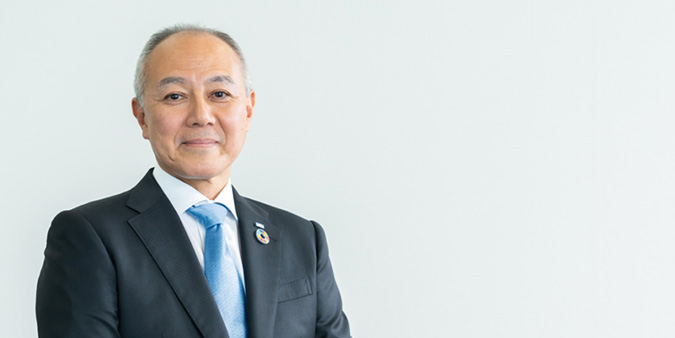
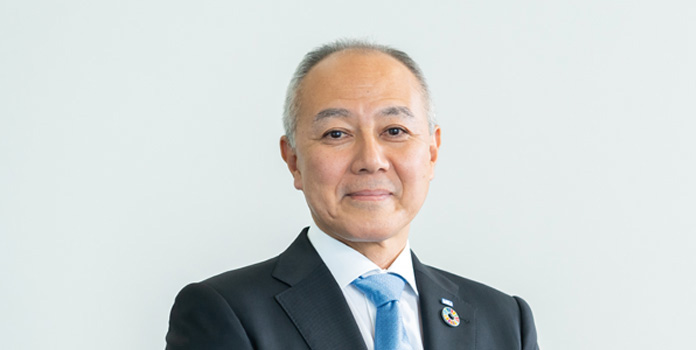
Shinji Tanaka
Representative Director, President
Creating business opportunities from
aluminum’s unlimited potential
A decade has passed since UACJ Corporation was established through a merger in October 2013, and since that time, the UACJ Group has grown as a major supplier of various kinds of aluminum products to a diverse range of customers around the world. In May 2021, we announced UACJ Vision 2030 as our long-term roadmap for contributing to sustainability through aluminum, and as an important step toward realizing this vision,we launched our new mid-term management plan spanning from fiscal 2024 to 2027 (April 2024 to March 2028).
In tandem with this new step forward, I was put in charge of leading the Company’s management with my appointment as representative director and president in April 2024. Since assuming this position, I have reaffirmed the importance of my responsibilities while feeling a strong desire to expand business opportunities by taking advantage of aluminum’s unlimited potential. I am especially excited now because the aluminum products industry is backed by more powerful tailwinds than ever before. Specifically, worldwide demand for aluminum products is rising on the back of economic growth in emerging countries of the Global South and elsewhere. Furthermore, aluminum is being recognized as a metal that can help solve global environmental problems, particularly ocean plastics and global warming-induced climate change.
For example, in the automotive industry, the electrification of automobiles and shift to electric vehicles is proceeding on a global scale as manufacturers tackle global warming-induced climate change, and aluminum is being adopted for body panels and structural components because it is lighter than steel and has a superior strength-to-weight ratio. This reduces the overall weight of vehicles, which helps improve their fuel efficiency. In addition, aluminum foil is used in lithium-ion batteries installed in electric and hybrid vehicles, and the metal is also indispensable for their battery casings.
Aluminum can be recycled endlessly. A vast amount of energy is required to produce virgin aluminum ingots through the process of converting bauxite to alumina, but the greenhouse gas emissions from that smelting process can be reduced by about 97% if aluminum ingots are recycled from used aluminum products instead. Therefore, we can reduce the environmental impact of aluminum production by recycling the metal over and over again.
Aluminum recycling has already made great progress in the beverage can industry. In Japan, almost all aluminum cans are recycled according to the Japan Aluminum Can Recycling Association. Its research found that the recycling rate of aluminum cans was 97.5% and the can-to-can closed loop recycling rate reached 73.8% in 2023. These exceptionally high levels have attracted attention worldwide. Indeed, in Europe and the United States, where environmental awareness is relatively high, aluminum is increasingly being used to make beverage containers.
In various industries besides the automotive and can stock industries, aluminum is being recognized for its excellent recyclability and contributions to reducing the environmental impacts of products. The UACJ Group has been receiving a growing number of requests from companies in such industries to supply aluminum products that can help them reduce CO2 emissions, and to develop recycled materials for new applications.
In response to such customer requests and the expectations of the public, I would like the Group to add even more value to its aluminum products and actively promote those benefits to many more people so that aluminum becomes even more widely used throughout society. I believe that UACJ has a major responsibility as an industry leader to significantly expand recycling initiatives and spearhead efforts to build a circular economy for aluminum together with a many different stakeholders.
When I joined Sumitomo Light Metal Industries (one of the two companies that merged to form UACJ) in 1987, demand for aluminum was growing in Japan mainly due to steeply rising sales of canned beer. Today, however, demand growth will be long term and continuous because it is being driven by efforts to tackle global environmental problems. Such a shift in the aluminum products industry happens only once every half century or so, meaning we have a vast range of business opportunities compared to when I joined the industry. In my view, failure to fully capitalize on these opportunities is the biggest risk facing the Company at this point in time. Therefore, we will make sure to seize these once-in-a-lifetime opportunities in the process of executing our new mid-term management plan from this fiscal year.
Pursuing four strategies with the goal of adding more value to aluminum products
After it was established in 2013, UACJ undertook large-scale capital investments to set up and expand production facilities in Thailand and the United States while its business in Japan struggled amid declining demand triggered by trade friction between the US and China. Consequently, the Company’s financial position weakened as it faced a very tough operating environment during the period of its first mid-term management plan (fiscal 2015 to 2017) and second mid-term management plan (fiscal 2018 to 2020). In response, we initiated a series of structural reforms from October 2019 to increase earnings capacity, reform the financial structure, and increase the speed and efficiency of management decision-making. As head of the Structural Reform Division at that time, I worked hard to execute reforms aimed at lowering the break-even point, optimizing production systems, streamlining and selling off businesses, and reducing the number of directors and executive officers.
When our third mid-term management plan (fiscal 2021 to 2023) commenced in April 2021, earnings capacity had improved thanks to the structural reforms, and production was on track at facilities built and expanded in Thailand and the US, greatly contributing to earnings. Then in fiscal 2022, we introduced additional reforms along with systems for passing on soaring market prices of energy and aluminum alloy additives to customers. At the same time, we adjusted our product prices to reflect the steeply rising commodity prices.
As a result of these efforts, the Company beat most of its key financial targets—including revenue, business profit*1, and the business profit margin—set for fiscal 2023, the final year of the third mid-term management plan. Having completed the structural reforms, boosted returns on investments in the US and Thailand, and renewed our product pricing systems, we built a solid operational foundation that can generate profit growth even if the operating environment suddenly changes.
We launched our fourth mid-term management plan on the back of these major achievements. Rather than extending the strategies of the previous plans, we will execute ambitious growth strategies under this new plan. One of our financial targets is ¥100 billion in adjusted earnings before interest, taxes, depreciation, and amortization (EBITDA)*2. To return profits to shareholders, the Company will aim to continuously pay stable dividends based on a dividend payout ratio of at least 30%.
To achieve the goals of the plan, our objective is to supply aluminum materials with even more added value than before. In the aluminum products industry, many flat-rolled aluminum manufacturers engaged in price competition in the past, and even when value was added to products through material development and processing technologies, it remained difficult to have that added value recognized in the marketplace. Later, however, as the industry reorganized globally, UACJ emerged as a leading player with a dominant share of the Japanese market following its establishment in 2013. Consequently, we view the Group not just as a materials supplier, but as a partner that meets the needs of customers through its abilities to develop specific materials, apply advanced processing technologies, and ensure a stable supply. Requests from our customers have become more sophisticated and diverse in recent years, and demand is growing rapidly for high-value-added products. They include products containing processed materials, and environmentally friendly products made of recycled materials and manufactured using green energy.
Positioning of the fourth mid-term management plan
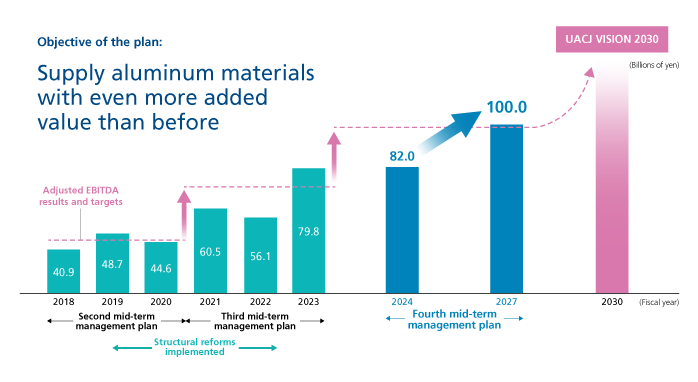
Under our new mid-term management plan, we have devised four strategies for capitalizing on changes in the market and substantially increasing earnings capacity: promote recycling, expand fabricated material businesses, help stabilize supply chains in technologically advanced industries, and grow new businesses. In these ways, we intend to add even more value to the materials we supply.
The first strategy of promoting recycling is the most crucial for the Group’s future. I will discuss it in detail below.
The second strategy of expanding fabricated material businesses involves adopting the same business model already used by UACJ Automotive Whitehall Industries, Inc., in the automotive parts industry for a broader range of businesses in the future. As the first step toward accelerating the development of such fabricated material businesses, UACJ integrated its former extrusion business and precision-machined components business into its new Extrusion and Metal components Business Division effective from January 2024. By making the most of aluminum’s heat conduction and dissipation properties, we also plan to develop fabricated material businesses in the air conditioning and heat management system industries, and model these businesses after the Group’s automotive parts business.
The third strategy is to help stabilize supply chains in technologically advanced industries. Specifically, we intend to offer highly advanced, high-value-added products to the battery, semiconductor manufacturing equipment, aerospace, and defense industries, which all require a stable product supply in Japan. Toward this end, UACJ established a new Aerospace and Defense Materials Business Division effective from October 2024, and will carry out customer- and market-oriented projects.
Finally, our fourth strategy is to grow new businesses, specifically in the mobility, lifestyles and healthcare, and environment and energy sectors, which we have targeted in our long-term roadmap, UACJ Vision 2030.
- *1 Business profit is operating profit excluding the effect of the metal price lag as well as temporary and extraordinary factors
- *2 Adjusted EBITDA is EBITDA excluding the effect of the metal price lag
Expanding the range of recyclable products while leading efforts to build a circular economy for aluminum
Returning to our strategy of promoting recycling, this will be important for adding value to aluminum materials and essential for the Group’s sustainability and business growth over the medium and long terms. In collaboration with recycling firms and the manufacturers it supplies products to, UACJ has been working hard to promote aluminum product recycling, particularly aluminum beverage cans. As I mentioned above, the aluminum can recycling rate in Japan reached 95% in 2023, and this was made possible by the adoption of recycling systems backed by legal requirements for sorting, collecting, and recycling containers. Still, many challenges must be overcome to recycle aluminum products other than cans. For that reason, UACJ is not able to recycle all of its aluminum products. In fact, the Company’s recycling rate for all products, including cans, was about 65% in fiscal 2019.
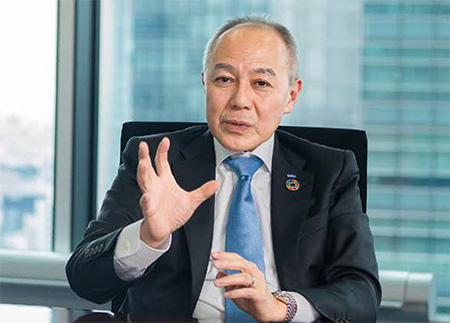
To increase this rate, UACJ will work together with its customers and stakeholders to build new supply chains in which used aluminum is collected from a wide array of industries, including the automotive industry, and recycled for new products. By applying the Group’s alloy development expertise and casting equipment and technologies, we intend to develop and manufacture recyclable products and supply them to customers, thereby increasing the amount of recycled aluminum. The goal of our long-term vision is to raise the Company’s recycling rate to 80% by fiscal 2030.
If we can achieve this goal, the aluminum recycling loop will grow and virgin aluminum production will decrease as more aluminum products are recycled, greatly reducing environmental impacts. The environmental benefits of recycling add more value to aluminum products, which will, in turn, speed up their widespread adoption. We are confident that this will also substantially contribute to the Company’s profit growth. The recycling loop that we envision and aim for is a circular economy for aluminum. As an industry leader, UACJ will strive to play a central role in this circular economy while strengthening links between upstream and downstream supply chains to expand its earnings base.
Various challenges will have to be overcome to build such a circular economy. One major issue, for instance, is how to create a system for continuously collecting used aluminum automotive parts, which have a much longer lifecycle than aluminum cans. Moreover, as a wider range of products are collected for recycling, the number of aluminum grades and alloy types will also increase, so advanced processing technologies will be needed to enable close-looped recycling systems. Even in the current recycling loop for aluminum cans, we must cut down on the number of overlapping processes to raise efficiency and reduce environmental impacts. Toward this end, UACJ teamed up with Sumitomo Realty & Development Co., Ltd., and Toyo Seikan Group Holdings, Ltd., in March 2024 to set up a can-to-can closed-loop recycling system at office buildings in Tokyo. By collaborating with various stakeholders to newly establish recycling loops like this, I believe we will be able to create all-new business models going forward.
Overcoming the challenges ahead will take time, of course, but we hope to develop optimal solutions by leveraging our long-established manufacturing capabilities and the trust we have built up with partners from various industries as we strive to achieve the goals of UACJ Vision 2030. To expand recycling through sustainability initiatives, we have placed priority on recycling in our new mid-term management plan, and will work to create environmental value by establishing new recycling systems.
Vision for an expanded recycling loop
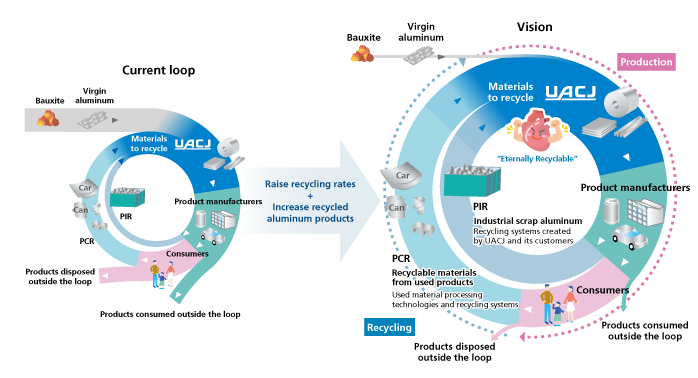
Having all employees of the Group commit to the new mid-term management plan and help achieve its goals
To realize UACJ Vision 2030, it will be essential to execute every measure of the new mid-term management plan and achieve its financial targets by the time it ends in fiscal 2027. Therefore, management is working to ensure that all employees of the Group worldwide fully understand the plan so they can work together toward accomplishing its objectives. We want employees to identify with and contribute to the main themes of the plan: create earnings, build partnerships, and promote the environmental benefits of aluminum.
Firstly, creating earnings is essential for the Group’s survival and has been a priority issue for management because earnings did not grow in line with targets following UACJ’s establishment. Therefore, I want employees to understand how we must create earnings by launching new initiatives and adding more value to our products.
In order to create earnings, it will be critical to build partnerships. The circular economy for aluminum I spoke of earlier cannot be established by the Group on its own. We will need to build on our relationships with various stakeholders in the supply chain, including manufacturers of diverse products, distributors and retailers, consumers, government agencies involved in waste collection, and recycling firms. Our partnerships are not limited to recycling, however; to develop products with even more value, employees must work together and organizations must cooperate beyond the boundaries of business divisions and departments. To facilitate such interdivisional cooperation, we are integrating businesses into organizations that can handle a diverse range of customers’ needs, such as the Extrusion and Metal Components Business Division and Aerospace and Defense Materials Business Division mentioned above.
Finally, promoting the environmental benefits of aluminum creates opportunities for all members of the Group to reaffirm the essence of our corporate slogan, “Aluminum lightens the world,” and our purpose statement, “Contribute to a prosperous and sustainable society with technologies that bring out the innate power of Materials.” I want all employees to appreciate how important this endeavor is for the new mid-term management plan.
After announcing the new plan, we began organizing town hall-style meetings at various workplaces of the Group to share the plan’s concepts, specific policies, and goals with employees on the front lines of operations. I have been attending these meetings to explain the plan and our management policies going forward, and to discuss what we should do in our workplaces to execute growth strategies and achieve targets. Employees have responded to the new plan very positively, and they have a solid understanding of our management philosophy and business strategies, thanks to many discussions held between employees and management in past years. Therefore, I am confident that the Group’s members are committed to executing the measures of the plan and will do their best to help accomplish all of the plan’s goals.
To help the Group’s employees reach their full potential, I want to implement programs and systems for enhancing their well-being. At UACJ, we believe that being healthy, fulfilled, and happy are vital for each employee’s well-being. When we renewed the Group’s materiality issues in fiscal 2023, we positioned well-being on the same level of importance as the global environment, and specified two materiality issues related to well-being: Respecting Human Rights, and Promoting Dei-ay (DE&I). In December 2023, we announced a declaration on the Group’s commitment to promoting DEI. It aims to allow all employees to demonstrate their abilities and contribute to innovations, which are vital for the Group’s sustainable growth.
I feel that UACJ has become a more diverse company since its establishment in 2013. For example, while each of the two companies that merged to form UACJ account for about one-third of the Company’s employees, respectively, the remaining one-third are mid-career employees hired after the merger. Consequently, the Company is made up of people with a wider range of backgrounds, outlooks, and experience. By ensuring that our diverse employees can make the most of their abilities, we hope to spark new innovations in the years ahead.
We established the UACJ Group Health Management Policy in 2021, and have been stepping up efforts to help employees manage and improve their health. As an indicator of this progress, UACJ was recognized for its outstanding “health and productivity” performance among large-scale organizations in Japan in 2022 and 2023 by the Nippon Kenko Kaigi, a Japanese health association. In 2024, that association together with the Ministry of Economy, Trade, and Industry selected the Company as one of the Japan’s top 500 “health and productivity” organizations for the first time. In the same year, UACJ was also recognized for the first time by the ministry and the Tokyo Stock Exchange for its outstanding “health and productivity” performance.
Building on this momentum, we will continue efforts to enhance the well-being of the Group’s employees and maintain comfortable work environments for all members of the workplace as we strive toward achieving the goals of our mid-term management plan.
Leveraging production expertise and organizational capabilities to create new value for the future
When my career first began, I was initially assigned to a manufacturing division. My first big assignment was to devise a plan to boost our aluminum can stock capacity by six times within a single year, from 500 tons to 3,000 tons per month, in order to meet rising demand for aluminum cans used for beer and other beverages. Before creating the plan for that ambitious challenge, I received some advice from my boss. He told me to go to the company’s factories to check what was happening, and confirm whether any problems had arisen onsite. Because I followed this advice, I was able to complete the assignment. Looking back on that now, the approach I learned is based on our five basic principles of action: understand how our factories operate, know our products inside and out, recognize how everything actually works, act rationally, and make decisions based on established rules. Because I learned these principles from the start of my career, when unforeseen problems happened later on, I was able to understand what was happening and take appropriate actions in line with the rules we had in place. I am not the only one to have done so, of course, because these principles are deeply ingrained in our corporate culture. Indeed, the principles of acting rationally and following established rules have enabled employees to pass down, develop, and improve the technologies and expertise underpinning the Company’s flat rolled aluminum production, which are among its biggest strengths.
In addition to these manufacturing capabilities, a source of the Group’s inherent organizational strength is the UACJ Way, a set of guidelines for all employees to follow based on three values: respect and understand your associates, embrace honesty and foresight, and be curious and challenging. Guided by these values, our employees in workplaces around the world are sincerely dealing with customers and taking on the challenge of creating beneficial new products with a future outlook. I am confident that by combining their skills and talents, we will be able to complete the new mid-term management plan and realize our long-term vision.
The UACJ Group is working to maximize the potential of aluminum to create a wide range of beneficial products and expand applications for the metal. In this way, we hope to reduce environmental impacts while helping build a better world and a healthier environment. As the Company’s president, I believe my biggest responsibility is to bring us closer to such a future by accomplishing the goals of our mid-term management plan and meeting the expectations of all stakeholders. Accordingly, I will do my upmost to win over the backing of stakeholders by actively engaging in dialogues to explain our current endeavors and plans, while determining what capital market investors expect from the Company. We look forward to their ongoing support of all stakeholders in the future.

